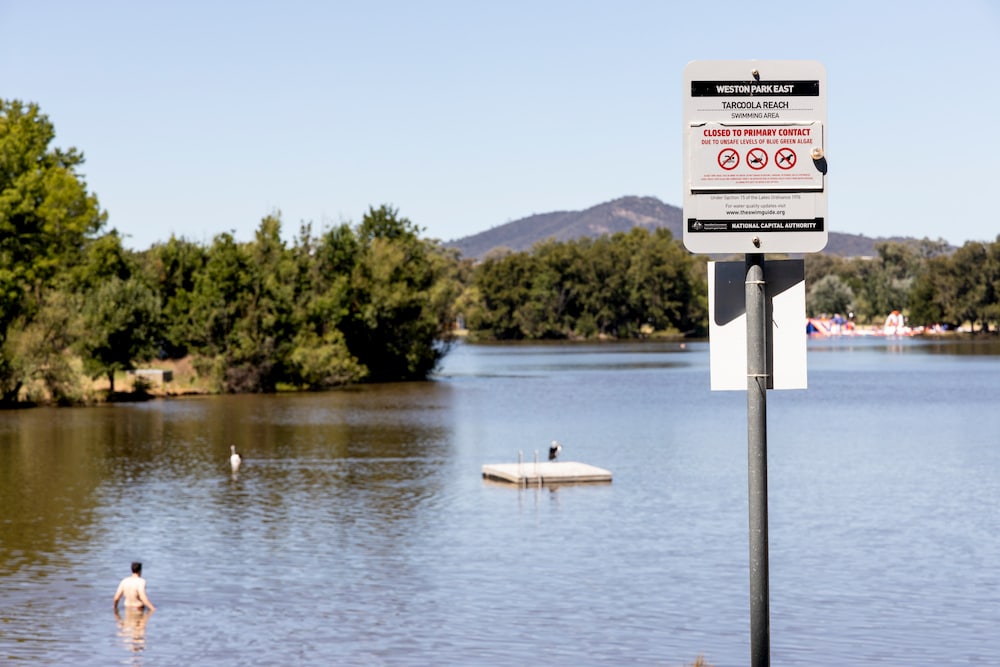Toxic algae and bacteria outbreaks in the ACT’s waterways have left swimmers feeling slightly blue, if not green about the gills.
Lake Burley Griffin, Lake Ginninderra, Lake Tuggeranong, Point Hut Crossing, Tharwa Bridge, and Paddy’s River are all closed for swimming at present.
Extreme levels of blue-green algae (cyanobacteria) were found in Lake Tuggeranong, and low levels in Lake Ginninderra and at Molonglo Beach.
Toxic levels of bacteria were found at other sites, at some places up to eleven times the point where water is deemed unsafe (200CFU / 100mL of intestinal enterococci).
Lake Ginninderra:
- Bimbi Beach: 1100CFU/100mL
- Dulwa & Negi Bamir Beach: 1800CFU/100mL
- Bargang Beach: 1600CFU/100mL.
- Yerra Beach: 250 CFU/100mL
Lake Tuggeranong:
- Tuggeranong Town Centre: 480CFU/100mL
- Ngadyung Beach: 1100CFU/100mL
- Nguru Beach is also closed
Murrumbidgee River Corridor/Paddy’s River:
- Point Hut crossing: 2300 CFU/100mL
- Tharwa Bridge: 970CFU/100mL
- Paddy’s River (Murray’s Corner): 290CFU/100mL
The public is advised not to swim, dive, water-ski, or windsurf in these areas. Rowing, fishing, boating, and canoeing is still permitted, but people should only do so if they are experienced; are informed of the algae risks, and what to do if contact occurs; and if shower facilities are available.
Blue-green algae can cause unpredictable reactions, depending on sensitivity to the algae or underlying medical conditions. Symptoms include skin rashes, vomiting, diarrhoea, fever, and asthma.
Exposure to bacteria can result in enteric (intestinal) illnesses such as self-limiting gastroenteritis.
What has caused the outbreak?
Blue-green algae occur naturally in most ACT water bodies, usually in low numbers and in balance with other aquatic life, an ACT Government spokesperson said. But algae can get out of control. Given the right environmental conditions – warm weather, low rainfall, and the right mix of nutrient levels – the algae can rapidly increase to high concentrations which then pose a health risk.
Algal blooms have been common across Canberra’s lakes due to a build-up of nutrient load, Helen Oakey, executive director of the Conservation Council ACT Region, explained. Fertilisers, sediment, grass, and leaves run into the storm water and then gather in the lakes, which act as holding ponds. Increased rainfall can stir up the sediment, and combined with warmer conditions, blue-green algae can develop.
Recent rainstorms are also to blame for bacterial pollution. Heavy rainfall can wash sewerage effluent overflows or animal faeces into waterways. Dead animals may contaminate water in rural and park areas.
What is the ACT Government doing?
“To protect our waterways and maintain water quality, we must learn to better manage what is flowing into the stormwater and rivers,” Ms Oakey said. “While Canberrans love to use the lakes and rivers for recreation, we don’t quite see ourselves as a ‘river’ city, despite being part of the Murray Darling system.”
The ACT Government’s $93.50 million ACT Healthy Waterways Project aims to improve storm water quality entering lakes and waterways, and flowing downstream into the Murrumbidgee River system. Wetlands, ponds, and rain gardens have been built in the Territory, including seven in the Lake Tuggeranong catchment to intercept up to 20% of the nutrient pollution.
“There isn’t a quick solution to improving water quality, and the Government is taking a long-term approach to water quality improvements, works, and measures to control algal blooms in the lakes and rivers,” a Government spokesperson said. “The new assets are contributing to the steady progress.”
The Conservation Council would like the ACT Government to continue and expand the Healthy Waterways Project, and to support the community to improve stormwater quality, Ms Oakey said.
What can you do?
“Rain gardens and water-sustainable urban design should be business as usual for all Canberra households, and not just in new developments,” Ms Oakey said. “While investment in wetlands and ponds over the last decade has helped manage stormwater flows, there is more the community can do at a household level to protect the ACT’s waterways.”
- Make sure grass clippings and tree leaves from your property does not end up in the drains. Put them in the compost or garden.
- Apply fertilisers to gardens and lawns sparingly, in between big rainstorms, and not right before.
- Put in rain gardens or swales to capture water and minimise runoff from your garden. This keeps water on the block for gardens.
- Clean up after your pet. Animal waste going into stormwater drains may form bacteria. “Washing something down the drain isn’t an appropriate way to dispose of animal waste!” Ms Oakey said.
Other information
ACT Health will test recreational sites each week to monitor algae and bacteria levels and ascertain the safety of lakes and rivers.
Algae levels can change quickly. Water users should look for algae warning signs that indicate the current algae alert level. Warning signs are located at public access areas. For more information on ACT blue-green algae and alert levels, visit Access Canberra.
Swim Guide also lists whether beaches are open or closed.
Avoid contact with algal scum. Wash clothing that has been in the water to remove blue-green algae residue.
Information on symptoms of blue-green algae exposure can be found here.
See your GP if you are concerned about possible symptoms of blue-green algae exposure.
Water event organisers should ensure all participants are aware of the blue-green algae alert level and the associated exposure risks, and provide adequate shower facilities.
Pet owners should not allow their animals to swim in or drink the water. Blue-green algae can make pets very ill, and in some instances can be fatal.



